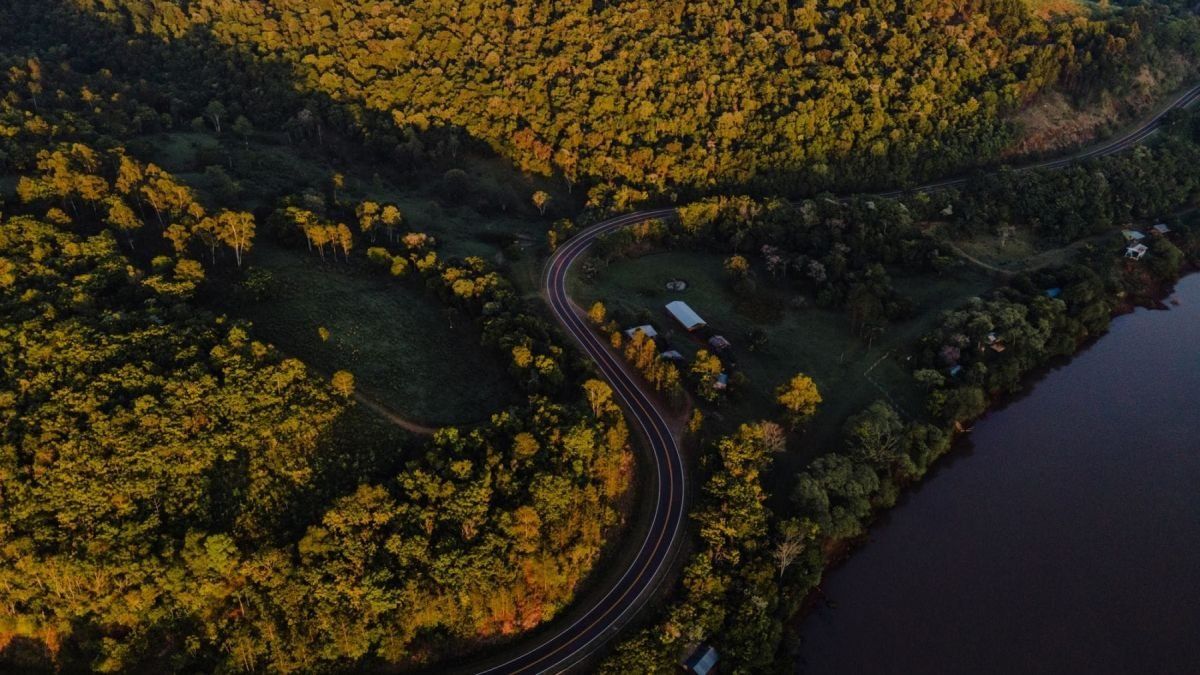This route is the obligatory land access from the south to visit the Iguazu Fallsone of the 7 New Wonders natural of the planet and declared World Heritage by UNESCO.
https://graph.facebook.com/v8.0/instagram_oembed?url=https%3A%2F%2Fwww.instagram.com%2Fp%2FCdOAjPPO9Zz%2F&access_token=EAAGZAH4sEtVABALPSAtsKaj3xnhAXnc4qDWkmYy4xUJQtLTZBT6ZC7zdtbHqZBdWRMvRaX6Np3xJFhODXOq2ZBBvTvRLRqmOLLR8hkWMQx1eXVDrj5TolWi6tB3aGH9SpbLGCzWD0bJzgQpXnQVCnU33YLRKY5FJNhPhT6tZBbtAZDZD
The National Route 14another of the main arteries of Misiones also crosses the province from south to north, although through the center of its territory and parallel to the central mountain system, the Misiones Mountainswhich extends as the backbone of the province.
On its way north, the 14 becomes increasingly more intricate and offers the traveler the view of the hills and deep valleys covered with jungleto culminate in the town of Saint Peterwhere is the Yabotí Biosphere Reservea protected natural area of more than 221,000 hectares, which is part of the Paraná Jungle.
https://graph.facebook.com/v8.0/instagram_oembed?url=https%3A%2F%2Fwww.instagram.com%2Fp%2FChexkwtrPlV%2F&access_token=EAAGZAH4sEtVABALPSAtsKaj3xnhAXnc4qDWkmYy4xUJQtLTZBT6ZC7zdtbHqZBdWRMvRaX6Np3xJFhODXOq2ZBBvTvRLRqmOLLR8hkWMQx1eXVDrj5TolWi6tB3aGH9SpbLGCzWD0bJzgQpXnQVCnU33YLRKY5FJNhPhT6tZBbtAZDZD
The provincial coastal route 2also called Pope John Paul II routehas its beginning in the town of Azara and culminates in Moconá Fallswith its waterfalls transversely to the riverbed.
This route borders the Uruguay Riverwith few places for passing vehicles, and proposes a jungle and water landscapein a route dominated by vegetation, sandy coasts and beaches, deep reedbeds and panoramic points of singular beauty.
In it, there are sections that enter the jungle to such an extent that it is possible see endangered animals and with a great diversity of flora, making it ideal to visit with the family.
https://graph.facebook.com/v8.0/instagram_oembed?url=https%3A%2F%2Fwww.instagram.com%2Fp%2FCelgqy7rJFP%2F&access_token=EAAGZAH4sEtVABALPSAtsKaj3xnhAXnc4qDWkmYy4xUJQtLTZBT6ZC7zdtbHqZBdWRMvRaX6Np3xJFhODXOq2ZBBvTvRLRqmOLLR8hkWMQx1eXVDrj5TolWi6tB3aGH9SpbLGCzWD0bJzgQpXnQVCnU33YLRKY5FJNhPhT6tZBbtAZDZD
There are other provincial routes that cross Misiones from east to west, such as the 1, 2, 4, 7, 9, 17, 19 and 20which in addition to communicating numerous towns and cities, offer interesting visual attractions to tourists.
For example, the path County 7unite Jardín América and Aristóbulo del Valle with very sinuous paths, so its circulation must be done with great caution because it is in areas of precipices, and it has viewpoints to observe the immensity of the jungle from different heights.
The route County 9Starts at Alba Possegoes through Santa Rita and May 25and reaches the path National 14with a route with very steep slopes and dangerous curves, which require great caution when driving.
https://graph.facebook.com/v8.0/instagram_oembed?url=https%3A%2F%2Fwww.instagram.com%2Fp%2FCg-czBuJCu9%2F&access_token=EAAGZAH4sEtVABALPSAtsKaj3xnhAXnc4qDWkmYy4xUJQtLTZBT6ZC7zdtbHqZBdWRMvRaX6Np3xJFhODXOq2ZBBvTvRLRqmOLLR8hkWMQx1eXVDrj5TolWi6tB3aGH9SpbLGCzWD0bJzgQpXnQVCnU33YLRKY5FJNhPhT6tZBbtAZDZD
The County 17what CONECT Eldorado, Pozo Azul and Bernardo de Irigoyen, also has very steep slopes and a winding route, so it can be classified as a dangerous route, because it is also very busy. While the Provincial 101 It is a route that crosses the heart of the National Park Iguazu up to Bernard of Irigoyenlocality of the provincial east in the dry border with Brazil.
in the commune of Andresitoshortly before that limit, also crosses the Urugua-í Provincial Parkwhich is the largest protected area in Misiones, with trails through the jungle and “fauna passes”which are large jungle bridges over the route, which the animals use to go from one place to another without the risk of being run over.
In the area, you can see the largest animal in the jungle: the tapirand in the Urugua-í stream live the yacutingaslarge and very showy birds that are emblem of the missionary jungle.
https://graph.facebook.com/v8.0/instagram_oembed?url=https%3A%2F%2Fwww.instagram.com%2Fp%2FCAqiZLPJ7Fo%2F&access_token=EAAGZAH4sEtVABALPSAtsKaj3xnhAXnc4qDWkmYy4xUJQtLTZBT6ZC7zdtbHqZBdWRMvRaX6Np3xJFhODXOq2ZBBvTvRLRqmOLLR8hkWMQx1eXVDrj5TolWi6tB3aGH9SpbLGCzWD0bJzgQpXnQVCnU33YLRKY5FJNhPhT6tZBbtAZDZD
Given the large number of species that cross the route, vehicles must circulate at low speed to avoid running over any specimen. This condition is heavily controlled by the provincial governmentbecause the latest reports indicate that between 3,000 and 5,000 wild animals die each year on routes of the province for run overs.
Further south is the Provincial Route 103which links the localities of Santa Ana Oberá, Campo Ramón, Santa Rita and Alba Posse. It is a route also cataloged as dangeroussince it is framed on mountain ranges with very pronounced slopes, with the aggravating factor of the sinuosity in its layout.
Source: Ambito
David William is a talented author who has made a name for himself in the world of writing. He is a professional author who writes on a wide range of topics, from general interest to opinion news. David is currently working as a writer at 24 hours worlds where he brings his unique perspective and in-depth research to his articles, making them both informative and engaging.




